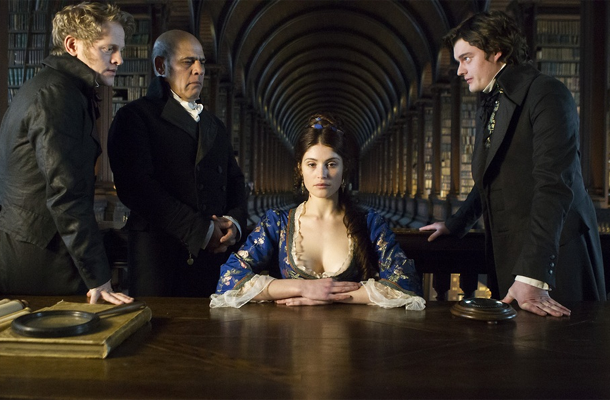Review: Byzantium (2012)

Cast: Gemma Arterton, Saoirse Ronan, Caleb Landry Jones
Director: Neil Jordan
Country: USA | UK | Ireland
Genre: Fantasy | Drama | Thriller
Official Trailer: Here
Editor’s Notes: Byzantium is now out in limited release. Check your local listing for showtimes.
Byzantium is the latest of a host of vampire films in recent years. A steady interest in revamping the old horror film favourite characters has been applied in various different forms and angled at interesting choices of audience demographics. These range from the shiny romantic types of the Twilight saga, to the strangely relatable figures of friendly family types in Hotel Transylvania. Byzantium is indeed a reworking of what the vampire narrative originated from, but in a subsequently new way that offers a fair amount of discourse on the topic.
Overall this is a fantastic vampire film: all the regular motifs are present and the flashback sequences offer a pastiche of film history and period settings.
Directed by Neil Jordan, who is well known for his previous work on the now somewhat of a cult classic vampire film Interview with the Vampire staring Brad Pitt and Tom Cruise, Byzantium already comes with a bit of a background for comparison. The similarities are instantly drawn between the use of young actors in the lead roles as the vampires, here Gemma Arterton and Saoirse Ronan mirror the places of Brad Pitt and Tom Cruise. Tackling a darker role with gothic themes, unfamiliar territory in terms of their film acting CVs for the two actresses and sure to offer them more diverse roles after their performances (I would here entertain the notion that this is true of Brad Pitt and Tom Cruise, but in retrospect these two actors continued their careers with bigger and lighter topic roles). Another similarity between the two films is their status as adaptations; Byzantium was adapted for the screen by writer Moira Buffini from her stage play with Neil Jordan on board as director after the adaptation, and Interview with the Vampire was adapted from Anne Rice by the author herself and again Neil Jordan on board as director.
 After the overwhelming success of Interview with the Vampire Jordan avoided working on vampire films until this project. A wise choice some might argue as it has allowed him to explore his filmmaking oeuvre without becoming too genre niche, although if he wasn’t the director of Byzantium I highly doubt there would have been so much hype before the theatrical release as it was marketed using Interview with the Vampire to draw in that same audience. For a while it did the rounds of festivals, admittedly this was largely as the odd higher budget feature that gains circuit attention because of the director’s filmography and status as an adapted screenplay. It has in this respect received the best possible distribution a producer could hope for: arthouse cinemas picking it up thanks to the festival attention, wider multiplex theatrical release due to the star power of the actresses, and substantial critical discussion because of the thematic content.
After the overwhelming success of Interview with the Vampire Jordan avoided working on vampire films until this project. A wise choice some might argue as it has allowed him to explore his filmmaking oeuvre without becoming too genre niche, although if he wasn’t the director of Byzantium I highly doubt there would have been so much hype before the theatrical release as it was marketed using Interview with the Vampire to draw in that same audience. For a while it did the rounds of festivals, admittedly this was largely as the odd higher budget feature that gains circuit attention because of the director’s filmography and status as an adapted screenplay. It has in this respect received the best possible distribution a producer could hope for: arthouse cinemas picking it up thanks to the festival attention, wider multiplex theatrical release due to the star power of the actresses, and substantial critical discussion because of the thematic content.
My main interest in the film’s thematic content runs along the vein of the use of the two female protagonists and of course the fact that they are vampires does add a wealth of critical opportunity. Similar again to Interview with the Vampire the narrative follows the retelling of the vampires’ story, their history of how they came to be vampires, their previous existences as mortal human beings and their current places in the world. Through the layout of the plot there are a lot of period style sequences where we learn the vampires’ unfortunate mortal circumstances. The younger vampire (Eleanor) is actually the biological daughter of the older vampire (Clara), who we learn was a prostitute forced to give up her baby to continue life in the brothel and forever live with that regret. Affected by so much bad health Clara is effectively on her death bed when a wealthy merchant patron is overheard discussing cures of what we are led to believe is syphilis or another fatal disease of a similar nature, so seizing her chance Clara steals a map said to show the whereabouts of the gift of eternal life. Once turned immortal Clara discovers her crime of theft won’t go unnoticed by an ancient male society of vampires that believe she committed the ultimate crime of turning herself without invitation. Clara is ostracised by the society and returns to the orphanage for Eleanor, saving her from another terrible fate by taking her to the illustrious fountain of life. The two vampires live out their days in hiding and Clara doesn’t tell Eleanor of the society that hunts her constantly.
 This is a seemingly varied representation of the female vampire, a postmodern take on female characters within a historically dense part of female representation in film. As vampires in film were historically monsters, the introduction of the female vampire began with them being monsters and gradually moved into them being beautiful creatures like sirens and progressed into the sexualisation of onscreen females. The Hammer horror studio is a good example of how the marketability of the female vampire switched from horrific monsters to icons of a combination of promiscuity and gore. Blood lust took on a literal and metaphorical sense, their desire for blood was mistaken by male characters as desire of a sexual nature and this is used creatively in Byzantium. Clara was a prostitute and continues this way of making money to look after herself and daughter as a vampire, again blurring the lines of desire except that her clients aren’t aware of her vampirism until she’s made the decision to kill them. Clara is dressed to kill as such, a very attractive woman who knows how to show off her body and have a certain look to attract attention from the type of men she both needs to survive and loathes due to her past. Clara is situated in the predicament of the onscreen female vampire and we sympathise with her partially because we as an audience understand this, but also partially because her character is made relatable and very human.
This is a seemingly varied representation of the female vampire, a postmodern take on female characters within a historically dense part of female representation in film. As vampires in film were historically monsters, the introduction of the female vampire began with them being monsters and gradually moved into them being beautiful creatures like sirens and progressed into the sexualisation of onscreen females. The Hammer horror studio is a good example of how the marketability of the female vampire switched from horrific monsters to icons of a combination of promiscuity and gore. Blood lust took on a literal and metaphorical sense, their desire for blood was mistaken by male characters as desire of a sexual nature and this is used creatively in Byzantium. Clara was a prostitute and continues this way of making money to look after herself and daughter as a vampire, again blurring the lines of desire except that her clients aren’t aware of her vampirism until she’s made the decision to kill them. Clara is dressed to kill as such, a very attractive woman who knows how to show off her body and have a certain look to attract attention from the type of men she both needs to survive and loathes due to her past. Clara is situated in the predicament of the onscreen female vampire and we sympathise with her partially because we as an audience understand this, but also partially because her character is made relatable and very human.
This is a seemingly varied representation of the female vampire, a postmodern take on female characters within a historically dense part of female representation in film.
Clara’s daughter Eleanor holds a unique stance as a female vampire. She is the key to the narrative as she’s the character telling the story. Similar to the young child vampire in Interview with the Vampire (played by a young Kirsten Dunst) Eleanor is turned to a vampire at a young age and is forever stuck in that state. Eleanor is forever a teenager wise beyond her physical appearance of years, and held back by a relatable teenager emotional outlook on the world. She’s unable to connect with others and is forced to live out her days with Clara, so she writes and rewrites her tale, romantically tossing the pages to the wind in an attempt to gain a deeper understanding of her situation in a form of therapy. All Eleanor desires is companionship, an elderly man who collects her pages offers his blood to her and later a relationship with a young man recovering from leukaemia presents an odd courtship. The male figures Eleanor has contact with place her as important and at the foreground as they wouldn’t be in the narrative without her retelling their part and seeing them as an event in her story.
As for Clara the male characters she interacts with are less sympathetic towards her, treating her with little respect and mirroring the male figures she knew during her life as a mortal. She’s either a figure of desire or something that shouldn’t be. The male characters in the narrative seem background material to the two female vampires. They largely form contrasts to the strange matriarchy that Clara and Eleanor have formed. Clara takes advantage of a middle aged male who owns a disused B&B on the seafront of a British holiday resort that has seen better days. The long forgotten living quarters become Clara and Eleanor’s new home, but Clara has forgotten that this is the same location where they started their story and all the action begins to unravel the normality they have created for themselves as forgotten debts need to be paid.
 Overall this is a fantastic vampire film: all the regular motifs are present and the flashback sequences offer a pastiche of film history and period settings. Byzantium did seem to fair well at festivals and in arthouse cinemas in the UK, but in multiplexes it was a relatively dismal flop for ticket sales. Gemma Arterton and Saoirse Ronan aren’t acting their socks off and seem by no means challenged by their roles, comfortable with the darker content the film provides. In terms of visuals the cinematography is nothing special but the locations, sets and costumes are quite befitting and don’t seem too indulgent. It is a more niche narrative with a bigger budget and some star power after all, but it’s a damn good one at that.
Overall this is a fantastic vampire film: all the regular motifs are present and the flashback sequences offer a pastiche of film history and period settings. Byzantium did seem to fair well at festivals and in arthouse cinemas in the UK, but in multiplexes it was a relatively dismal flop for ticket sales. Gemma Arterton and Saoirse Ronan aren’t acting their socks off and seem by no means challenged by their roles, comfortable with the darker content the film provides. In terms of visuals the cinematography is nothing special but the locations, sets and costumes are quite befitting and don’t seem too indulgent. It is a more niche narrative with a bigger budget and some star power after all, but it’s a damn good one at that.
Related Posts
![]()
Laura Shearer
![]()
Latest posts by Laura Shearer (see all)





























